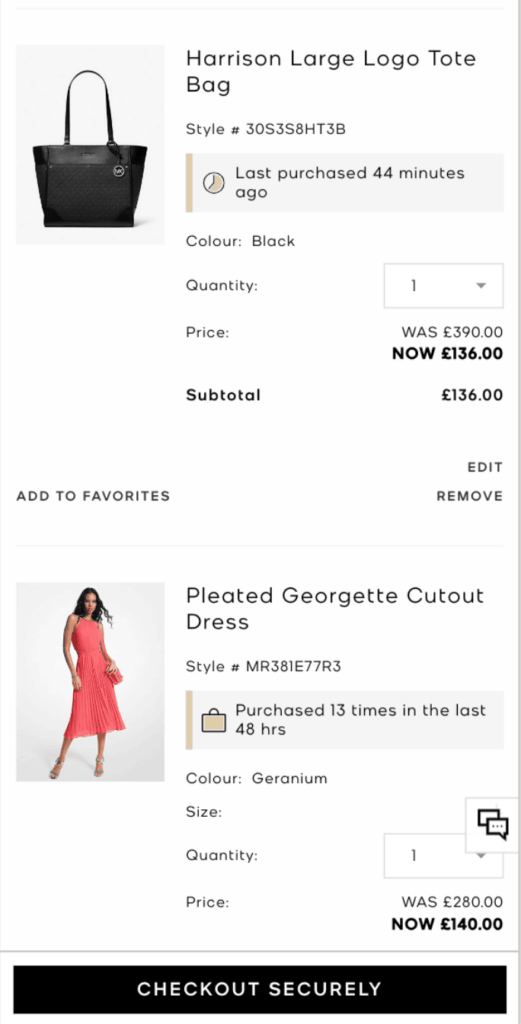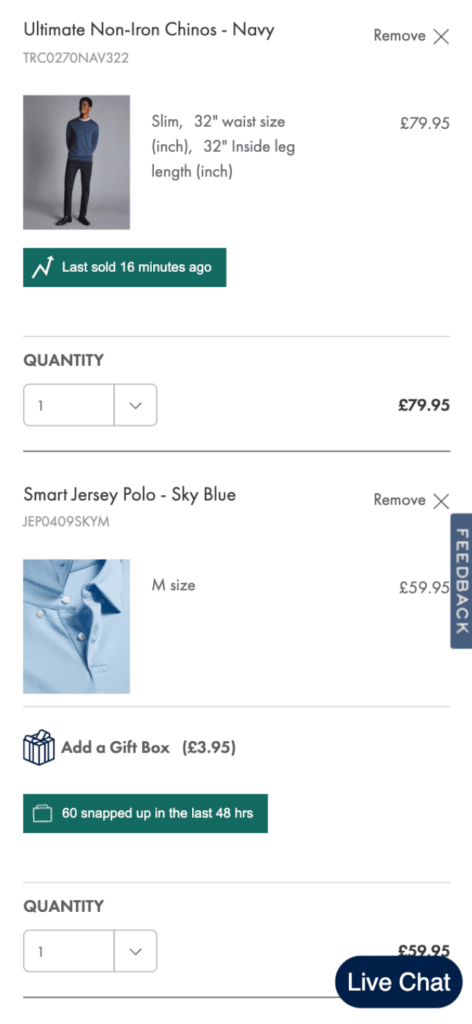You’re shopping online for a new pair of shoes. After browsing a few sites, you find a pair you like, select your size and add them to your cart. Before you check out, you decide to do one last search online to see if you can find a better deal and leave the site. You just abandoned your cart.
Cart abandonment happens when someone adds items to their online shopping cart but leaves the website without completing the purchase. It happens a lot in eCommerce – in fact, research from Baymard Institute shows that the average cart abandonment rate is 70.19%.
To combat high cart abandonment rates, smart retailers and brands constantly refine strategies and implement features designed to better encourage shoppers to complete their purchases, thereby decreasing the cart abandonment rate.
Why is cart abandonment a problem for eCommerce sites?
Cart abandonment has a direct impact on conversion rates and revenue, and therefore a major concern for retailers and brands.
When shoppers add items to their carts but fail to complete the transaction, potential sales and revenue are lost. Not only do cart abandonments result in reduced profits, but they also impact the ROI on your marketing spend as the money spent to acquire those consumers is wasted, not to mention the added value that happy customers provide as brand ambassadors.
High cart abandonment rates are also a concern because they often indicate underlying issues with the eCommerce site or checkout flow, signalling a need for an in-depth audit and increased resource allocation to improve the shopping experience.
What causes cart abandonment?
A large portion of cart abandonments are out of the control of eCommerce professionals – they are simply a consequence of how most consumers shop online now. Whether seeking inspiration, doing research or killing time while waiting for an appointment, many shoppers spend time on eCommerce sites and add items to their carts without a strong intent to buy. Simple distractions can also cause cart abandonment such as a phone call or kids running around the house.
These types of cart abandonments are hard to avoid, but there are a variety of other factors that can deter a potential customer from completing a purchase that can be addressed.
- Unexpected costs – such as high shipping fees or taxes, can lead customers to search for a better deal elsewhere.
- Poor checkout user experience – shoppers can be discouraged by lengthy and complicated checkout processes that require a lot of information or require them to create an account.
- Security concerns – worries about the safety of their personal information or payment details can cause shoppers to abandon their carts.
- Lack of payment options – shoppers may abandon their carts if the retailer doesn’t accept their preferred payment option.
- Limited or slow shipping options – the lack of multiple shipping options or slow shipping can deter shoppers from completing their transactions.
- Unsatisfactory return/refund policy – shoppers may abandon their carts if the return and refund policy is not competitive.
- Undecidedness or doubt – shoppers may not feel confident that they are making the right purchase decision, resulting in cart abandonment.
How to reduce cart abandonment with these key strategies
Understanding the underlying causes of cart abandonment for your specific business will help you refine strategies and implement features and functionality across the shopping journey to reduce cart abandonment. While strategies for how to reduce cart abandonment will vary from industry to industry, here are some ideas to get started. Some are simple fixes or redesigns others require new technology investments but will have a huge impact on your bottom line.
- Streamline the checkout process: Simplify the checkout process and make it frictionless by reducing the number of steps required to complete a purchase. A redesign of the checkout process with fewer field requirements can have a huge impact.
- Offer guest checkout: Provide an option for customers to checkout as a guest, without requiring them to create an account or login to their existing account.
- Provide transparent pricing: Clearly share all costs upfront, including shipping fees and taxes, to avoid any surprises at checkout. According to a recent study, 48% of cart abandonments happen because of unexpected and high extra costs (shipping, taxes and fees).
- Offer multiple payment options: Accept multiple payment options, including alternative payments and Buy Now Pay Later (BNPL), to make it easier for shoppers to buy.
- Offer free shipping: Consider offering free shipping, free shipping with a threshold (above a certain order value) or free shipping to loyalty program members (boost loyalty program membership) to incentivise customers to complete their purchase. Threshold messaging related to free shipping can also increase the average order value.
- Have a clear return policy: Share a clear and easy-to-understand return policy to reassure customers about their purchase.
- Use trust badges: Display trust badges and security seals to reassure customers about the safety of their personal information.
- Offer customer support during checkout: Offer live chat or clearly state customer support details on the cart and checkout pages to help shoppers who may have questions or encounter issues during checkout.
- Offer a wishlist and save cart feature: Allow customers to save items to a wishlist for future purchase. Shoppers should be able to add products to a wishlist from the PLP and PDP, as well as move an entire cart to the wishlist or save the cart for future purchase.
- Add social proof messaging: Integrate social proof messaging to build trust and instil confidence about the purchase decision with messages such as “5 people currently have this in their cart” or messaging that also highlights key attributes like “Organic cotton – 17 people eyeing this now”. Social proof messaging in the cart and at checkout also gives a sense of urgency by highlighting how many people have purchased a given product in real time e.g., “23 people have purchased this in the last 24 hours”.
- Use exit-intent popups: Offer discounts or incentives to shoppers who are about to abandon their carts via automated popups.
- Abandoned cart emails: Send automated emails to remind customers about their abandoned carts and encourage them to complete their purchase. Consider injecting social proof messaging into these emails to highlight trends and product popularity, reinforcing the shopping decision.

- Optimise for mobile: Ensure that your site is optimised for mobile devices to make the checkout process easy and convenient for mobile shoppers.
- Optimise page load times: Ensure that your site loads quickly to prevent customers from abandoning their carts due to slow loading times.
- Always use A/B testing: Continuously test different strategies and approaches to determine what works best for reducing cart abandonment on your site.
Why you should invest in strategies to reduce your cart abandonment rate
Some causes of cart abandonment are out of your control, like online window browsing or price comparison. However, as illustrated above, there are many strategies for reducing cart abandonment rates that are within your reach and fairly simple to implement.
Retailers and brands that invest in Taggstar’s social proof messaging platform quickly realise the benefits across the entire shopping journey. By implementing social proof messages in the cart and checkout pages, they give shoppers the extra validation that they are making the right choice at the most critical point of their shopping journey.

A specialty retailer found that checkout was 300% more likely for customers who saw Taggstar’s social proof messages than those who didn’t. Cart abandonment was 76% less with social proof messaging.
From small tweaks to new software investments, reducing your cart abandonment rate will significantly impact your conversion rates, online revenue, and profits. The improvements you make will also elevate the overall customer experience, which will lead to more loyal customers.
Check out our Conversion Calculator and learn more about how Social Proof Messaging can increase conversion rates, reduce cart abandonment, and increase revenue.



